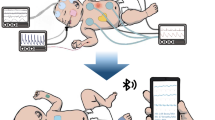Abstract
OBJECTIVE:
To analyze the effects of apnea duration on changes in heart rate and oxygen saturation and to examine the temporal relationships among these variables.
STUDY DESIGN:
An event analysis sheet was designed to analyze numerous variables reflecting changes in heart rate and oxygen saturation associated with infant apnea. From July 1, 1991 through June 30, 1992 we identified 32 infants enrolled in The Infant Apnea Program at St. Peter’s Medical Center, New Brunswick, NJ who had apnea ≥15 seconds in duration on consecutive 12-hour multichannel recordings of heart rate, thoracic impedance, nasal thermistry, and oxygen saturation. The apnea epochs of these patients were subdivided into apnea of short (10 to 14 seconds), medium (15 to 19 seconds), and long (≥20 seconds) duration, and a total of 236 apnea epochs were analyzed. The significance of differences was assessed by analysis of variance and Newman-Keuls multiple comparisons.
RESULTS:
We found that the duration of apnea has significant effects on perturbations in both heart rate and oxygen saturation, however, the degree of oxygen desaturation can not be predicted by the perturbation in heart rate. Analysis of the temporal relationship of apnea, bradycardia, and oxygen desaturation reveals that, although apnea precedes both heart rate and oxygen saturation drops in most infants as the length of apneic interval increases, the interval between apnea onset and associated drops in heart rate and/or oxygen saturation also increases.
CONCLUSION:
Oxygen saturation monitoring may provide important physiologic data that can not be assessed by cardiorespiratory monitoring alone.
This is a preview of subscription content, access via your institution
Access options
Subscribe to this journal
Receive 12 print issues and online access
$259.00 per year
only $21.58 per issue
Buy this article
- Purchase on Springer Link
- Instant access to full article PDF
Prices may be subject to local taxes which are calculated during checkout
Similar content being viewed by others
Author information
Authors and Affiliations
Rights and permissions
About this article
Cite this article
Carbone, T., Marrero, L., Weiss, J. et al. Heart Rate and Oxygen Saturation Correlates of Infant Apnea. J Perinatol 19, 44–47 (1999). https://doi.org/10.1038/sj.jp.7200072
Published:
Issue Date:
DOI: https://doi.org/10.1038/sj.jp.7200072
This article is cited by
-
Apnea of prematurity: pathogenesis and management strategies
Journal of Perinatology (2011)



